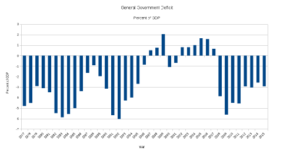Federal government deficits and surpluses – Editor
It is commonplace these days to hear media commentators, politicians, Q&A panellists and others regurgitating the mantra that federal budget surpluses represent sound financial practice while federal budget deficits do not. However the reality is that the reverse relation- ship generally applies, The belief that surpluses are always good and desirable represents nothing other than a perception — supported by dangerously flawed doctrine adhered to by main- stream (neoclassical) economists — that monetary sovereign governments are able and willing to save or store the money they create for the operation of the real economy. However this belief is logically and factually absurd.
Unfortunately, many of these same economists are so out of touch with monetary mechanics that they do not even recognise what MMT economists well understand – that each monetary sovereign government creates new money when it spends, and that money goes out of existence when taxes are paid to that government.
In this respect, the finances of state governments differ in a fundamental way from federal government finances. State governments are not monetary sovereigns, and so they do indeed need to store the money that they receive from tax payments and other sources. The problem is that politicians and members of the public generally do not understand this important difference.
 The new money created by the federal government when it “deficit spends” into the real economy can be alternatively described as net financial assets held by the non-government sectors. This money is absolutely required by these sectors for the purposes of saving, investing and spending. And this is why the secular trend in our economy is for budget deficits, not surpluses. Over the past hundred years, federal budget deficits have appeared for over 80% of the time, and it should be obvious that such a preponderance of deficits has occurred for a good reason. Moreover, the history of our economy reveals that every regime of budget surpluses has been followed in turn by recession. This statistic tells us something important about how our economy operates, and it should not be too surprising when we recognise that the federal government’s deficit spending represents the addition of liquidity and purchasing power to the real economy – while budget surpluses represent its withdrawal.
The new money created by the federal government when it “deficit spends” into the real economy can be alternatively described as net financial assets held by the non-government sectors. This money is absolutely required by these sectors for the purposes of saving, investing and spending. And this is why the secular trend in our economy is for budget deficits, not surpluses. Over the past hundred years, federal budget deficits have appeared for over 80% of the time, and it should be obvious that such a preponderance of deficits has occurred for a good reason. Moreover, the history of our economy reveals that every regime of budget surpluses has been followed in turn by recession. This statistic tells us something important about how our economy operates, and it should not be too surprising when we recognise that the federal government’s deficit spending represents the addition of liquidity and purchasing power to the real economy – while budget surpluses represent its withdrawal.
The answer to the question “from whom does the federal government borrow?” is that it currently borrows mainly from primary bond dealers, and secondarily from commercial banks and other large institutional investors. It does have the ability to borrow directly from the central bank (RBA) – which is effectively not borrowing at all – but “sound financial practice” has inhibited it from going down this path. The borrowing process merely replaces one financial asset with another, and the Treasury securities attract interest (i.e. unlike bank demand deposits, but note that the associated reserves – the exchange settlement balances – do currently pay interest).
Such borrowing should not be regarded as real debt, because Treasury bonds and notes can be thought of as a form of “broad” state fiat money, and also because in normal circumstances the government maintains the aggregate of its securities on issue at a prescribed level by issuing new bonds and notes in replacement of any that happen to be cashed in. Lastly, and contrary to popular belief, the interest paid on these securities does not come from taxation.



























